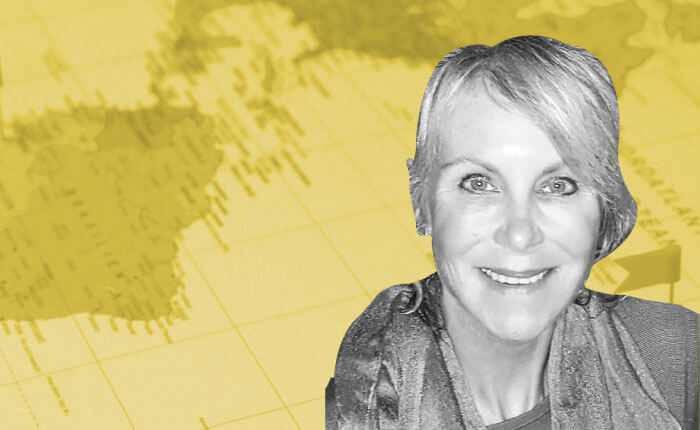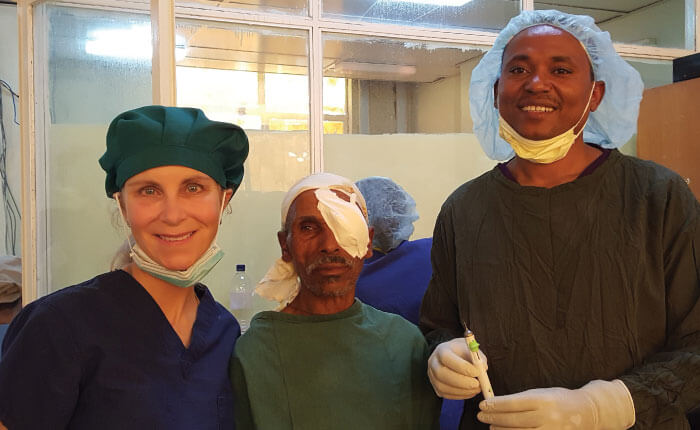
Tell us more about your outreach work.
For the last few years, I’ve worked with the ASCRS Foundation and its partners, teaching and helping to develop the Ethiopian residency programs. Our aim is to build infrastructure so that eventually Ethiopia will no longer have to rely on outside aid for eye care. We work with our partners to supply equipment and training. To give an example, Orbis and The Himalayan Cataract Project (HCP) have just set up wet labs at each residency hospital in the country. We are supporting the residency directors financially, and collaborating with them to improve educational programs for residents. In March we will be teaching a review course to residents to help them study for the ICO Board Exam. The ASCRS Foundation also supports the Sinskey Eye Clinic, which serves the impoverished, and now provides a rotation for the residents to improve their clinical and surgical skills.
Right now, most residency programs – and ophthalmologists – in Ethiopia are based in the big cities, which isn’t good news for patients in remote areas. In order to perform surgery in some of these places, a team has to transport all their own equipment; in the south of the country – the poorest, more rural part – that could be a more than a day’s drive. Understandably, doctors practicing in those areas have to make do with offering a less technical level of care. These regions don’t have enough doctors, staff or equipment to provide surgery to all of those in need, which is something we’re trying to change.
What is the current state of care in Ethiopia?
There is about one ophthalmologist per million people in Ethiopia. That tells you that the current state of eye care is one of severe shortage. Although Ethiopia has a public healthcare system, there are not enough facilities that offer eye care, especially in the rural areas. Due to the lack of equipment and medication, even university hospitals may not be able to provide the level of care a patient may need. Not only that, the salary for ophthalmologists is so low in these government hospitals that doctors have no choice but to support themselves in private practice at least part-time.
Now that five residency programs are up and running, the number of ophthalmologists in the country is growing quickly. Still, it may be many years before there are enough doctors to serve all of the patients in need of care.
Hundreds of patients come to the public clinics without appointments every day, hoping to be seen. The majority come from remote villages, traveling for hours with their families. Of course, some people can’t afford the cost of transport and, unfortunately, have to go without. There simply aren’t enough clinics or doctors – and certainly not enough in remote areas.
What are the most common cases you deal with?
You might think that the majority of cases are tropical diseases, but that’s not the case. Most residents have never even seen active trachoma, thanks to the great work being done to eradicate it. They certainly do see corneal scarring though, and eyelid surgery for trichiasis is a common procedure. Cataracts is the most common cause of blindness, which is sad and frustrating, as it is treatable with a quick and inexpensive operation.
We tend to see a lot of injuries from farming and other accidents as, unfortunately, laborers don’t tend to use protective eyewear. Interestingly, a new problem they are facing is one common in developed countries: diabetic retinopathy. To add to the increased severity of eye conditions, there is a constant lack of medications that we take for granted. I remember meeting a young man with chronic vernal conjunctivitis. The only treatment his doctors had access to, in order to keep it under control, were steroid drops. He was on them for so long he developed glaucoma and now has permanent damage to his optic nerve.
Any success stories to share?
Well, almost all cataract operations are success stories. But there are many situations less glamorous, but just as impactful. A man once came to me saying he had to stop working as a radio repair man because he could no longer see the parts. All I did was give him a pair of $1 reading glasses and he could see clearly. It sounds like such a small thing, but those over-the-counter reading glasses gave him the ability to earn an income again. He told me I saved his career, and his whole family.
The number of people blind from cataracts is a huge challenge…
It is estimated that one million people are completely blind from cataracts in Ethiopia. The number of operations per year in all the public hospitals barely makes a dent in that number. NGOs set up remote eye camps and, remarkably, do up to 1,000 operations in a week. Still, this is a drop in a bucket. However, at these eye camps the local medical personnel is being trained to set up their own facilities and outreach camps. As more Ethiopian ancillary personnel and ophthalmologists graduate, we hope that they can independently provide the care the country needs.
In developed countries, cataract surgery is most often performed using phacoemulsification, but that’s not standard for the majority of Ethiopian facilities. Not only is the equipment extremely expensive to buy, the consumable materials these machines require for each use are also expensive, and can be difficult to obtain in remote locations. Another roadblock is the lack of technicians trained to service the machines. Manual small incision cataract surgery (MSICS) is the standard of care for cataract surgery in Ethiopia and many other developing countries because it’s fast, safe, inexpensive and effective.
Cataract surgery isn’t just life-changing for the patient, it is life-changing for their entire family. Many young family members have to give up work to care for their blind loved one. Eliminating cataract blindness not only helps the patient and the family – it also improves the health and economy of communities and the entire country.
What advice would you offer to volunteers?
It’s not enough to just show up, do a few operations and leave. The goal is sustainable change – and that means taking the time to collaborate with local doctors, to “train the trainers.” We would like to inspire them to achieve the quality of care we have in developed countries. It doesn’t just mean developing their surgical skills; it also means helping with clinical skills, improving training programs, and strengthening infrastructure. Be open to learning from the residents, too. They will have seen severities of disease that you haven’t. You also have to respect that people communicate differently in other cultures. Maybe locals won’t tell you as much as you’d like them to, or they will say “yes” when you can tell they haven’t really understood the question. It is also worth being aware of how different cultures react to pain – do they express themselves with stoicism or grand displays of emotion? By learning side-by-side, working together to offer better care, and encouraging and training doctors on best practices for their patients, you will become a better doctor yourself.

